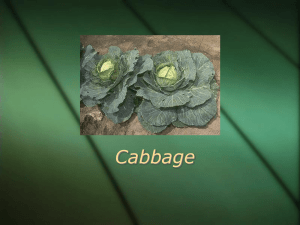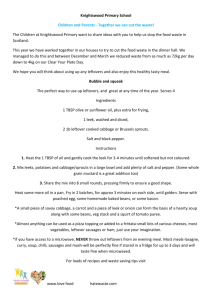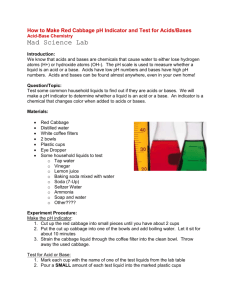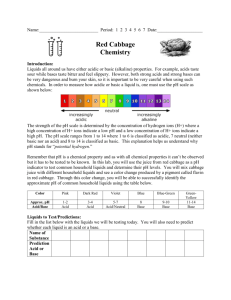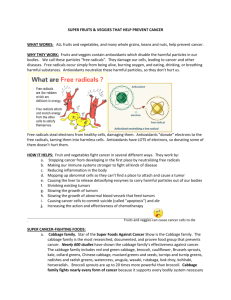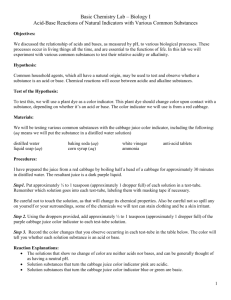Sauerkraut - University of Alaska Fairbanks
advertisement
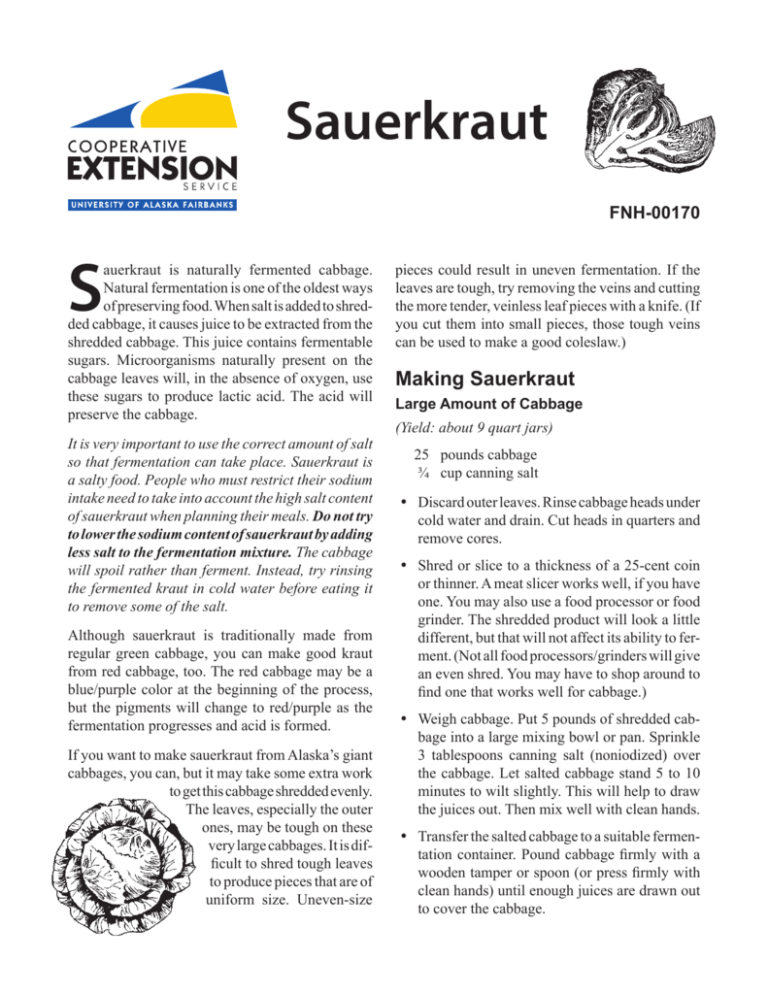
Sauerkraut FNH-00170 S auerkraut is naturally fermented cabbage. Natural fermentation is one of the oldest ways of preserving food. When salt is added to shredded cabbage, it causes juice to be extracted from the shredded cabbage. This juice contains fermentable sugars. Microorganisms naturally present on the cabbage leaves will, in the absence of oxygen, use these sugars to produce lactic acid. The acid will preserve the cabbage. It is very important to use the correct amount of salt so that fermentation can take place. Sauerkraut is a salty food. People who must restrict their sodium intake need to take into account the high salt content of sauerkraut when planning their meals. Do not try to lower the sodium content of sauerkraut by adding less salt to the fermentation mixture. The cabbage will spoil rather than ferment. Instead, try rinsing the fermented kraut in cold water before eating it to remove some of the salt. Although sauerkraut is traditionally made from regular green cabbage, you can make good kraut from red cabbage, too. The red cabbage may be a blue/purple color at the beginning of the process, but the pigments will change to red/purple as the fermentation progresses and acid is formed. If you want to make sauerkraut from Alaska’s giant cabbages, you can, but it may take some extra work to get this cabbage shredded evenly. The leaves, especially the outer ones, may be tough on these very large cabbages. It is difficult to shred tough leaves to produce pieces that are of uniform size. Uneven-size pieces could result in uneven fermentation. If the leaves are tough, try removing the veins and cutting the more tender, veinless leaf pieces with a knife. (If you cut them into small pieces, those tough veins can be used to make a good coleslaw.) Making Sauerkraut Large Amount of Cabbage (Yield: about 9 quart jars) 25 pounds cabbage ¾ cup canning salt yy Discard outer leaves. Rinse cabbage heads under cold water and drain. Cut heads in quarters and remove cores. yy Shred or slice to a thickness of a 25-cent coin or thinner. A meat slicer works well, if you have one. You may also use a food processor or food grinder. The shredded product will look a little different, but that will not affect its ability to ferment. (Not all food processors/grinders will give an even shred. You may have to shop around to find one that works well for cabbage.) yy Weigh cabbage. Put 5 pounds of shredded cabbage into a large mixing bowl or pan. Sprinkle 3 tablespoons canning salt (noniodized) over the cabbage. Let salted cabbage stand 5 to 10 minutes to wilt slightly. This will help to draw the juices out. Then mix well with clean hands. yy Transfer the salted cabbage to a suitable fermentation container. Pound cabbage firmly with a wooden tamper or spoon (or press firmly with clean hands) until enough juices are drawn out to cover the cabbage. How To Exclude Air (Oxygen) What Is a Suitable Fermentation Container? Either of the following methods may be used to keep oxygen from the cabbage/salt mixture so that cabbage will ferment properly. You may have less trouble with spoilage if you use method 1. Glass jars and heavy food-grade plastic containers are considered to be the safest fermenting vessels. Metal and non-food-grade plastic containers are not recommended. The acid in the kraut could extract metals or chemicals from these containers that could produce off-flavors and toxic products in the kraut. Method 1 One of the easiest and best ways to keep air out of the fermenting cabbage is to place a brine-filled plastic bag on top of the cabbage. This will also cover and weigh down the cabbage. To make brine, use 6 tablespoons salt/1 gallon water (1½ tablespoons/1 quart water.) Old ceramic crocks may contain lead and other toxic metals; the acid in the kraut could cause the lead to leach from the crock into the kraut, especially if the ceramic is cracked or chipped. New ceramic crocks may be expected to be low-lead or lead-free, and, if so, make excellent fermenting containers. However, since new ceramic crocks may be expensive, it is a good idea to ask about the lead content before investing in a ceramic crock. You may be able to purchase food grade plastic containers from local restaurants. A 5-gallon container will hold about 25 pounds of prepared cabbage. Use a heavy-weight, watertight plastic bag that is intended for use with food and that is not colored. Do not use plastic garbage/trash bags. For extra protection against leakage, the brine-filled bag may be placed inside another plastic bag. Add enough brine to the bag to give just enough pressure to keep the fermenting cabbage covered with its own juice — 3 to 4 inches is usually about right — then tie the bag securely. Method 2 An alternate method is to cover the cabbage with a clean cloth or clear plastic. Fit this cover smoothly against the sides of the container, then cover with a plate or other nonmetallic disk that just fits inside the container so that the cabbage is not exposed to the air. yy Weigh another 5 pounds of cabbage and repeat the procedure, placing the second batch of salted, wilted cabbage on top of the first. Continue layering 5-pound batches, pounding or pressing each layer to draw out juices, until fermentation container is filled to the desired depth. If you have less than 5 pounds of cabbage in the last batch, adjust the salt accordingly — just keep the proportion of 3 tablespoons salt/5 pounds of shredded cabbage. Put a weight on top of the cover so the juice comes to the cover but not over it. A glass jar filled with water makes a good weight. Store container with cabbage at 70°F to 75°F for fermenting. For best quality, select a location in which temperature will remain fairly constant. yy Leave about 4 or 5 inches of space between the cabbage and the top of the fermentation container. Cabbage should be covered with 1 to 2 inches of its own juice. If juice does not cover cabbage, add boiled and cooled brine (1½ tablespoons salt/quart of water). At temperatures between 70°F and 75°F, kraut will be fully fermented in about three to four weeks; at 60°F to 65°F, fermentation may take five to six weeks; at temperatures lower than 60°F, kraut may not ferment. Above 75°F, kraut may become soft. yy Next, cover the cabbage to exclude air. This step is critical because fermentation will take place only in the absence of oxygen. If you use weights other than the water/brine-filled plastic bags, you will need to check the kraut two 2 Illustration from USDA Complete Guide to Home Canning, Agriculture Information Bulletin No. 539. 9-94. needed. Allow it to cool before coming in contact with the cabbage. yy Prepare cabbage as described for making a large amount of kraut. yy Shred cabbage into a sterilized pan or bowl. If you use a kraut grater, you will get uniform cabbage slices and increase your chances for success with this method. yy Weigh the grated cabbage and combine with noniodized salt, using 3½ tablespoons salt for every 5 pounds of shredded cabbage. (If cabbage head has been stored for a month or so, add 1 tablespoon sugar to the recipe.) to three times each week (or even every day) and remove scum if it forms. Some people like to examine the kraut as it ferments and choose method 2 to follow the kraut’s progress. After checking the kraut, re-cover container with clean plastic or cloth. yy After thoroughly mixing cabbage with salt, allow it to stand for several minutes to wilt somewhat. This step is important. It will help to draw juices from the cabbage. It is not necessary to check kraut weighed down with water/brine-filled plastic bags. Some directions for making sauerkraut tell you not to disturb the kraut while it is fermenting when you use this method of weighing it down; others say it is okay to peek every so often if you want to check the kraut’s progress. yy Pack the cabbage firmly into the jar, filling jar to the top. Press down firmly until juice runs out of the cabbage and covers it completely. For best results, try to press enough juice from the cabbage to cover it completely. If you cannot press out enough juice to cover cabbage, try adding boiled and cooled brine (1½ tablespoons salt/quart of water) until cabbage is completely covered. Look for these indicators to help recognize when sauerkraut is ready (fermentation completed). yy Cabbage changes from opaque, green-white to translucent, golden color. To eliminate air so cabbage can ferment use either of the following methods: yy Product smells like sauerkraut. 1. Put a sterilized lid on the jar just tightly enough to keep out air. Sometimes the absence of bubbles serves as an indicator, but this may be misleading. It is hard sometimes to see bubbles, and bubbles also could indicate the start of additional, unwanted fermentations. 2. Weigh down with a brine-filled plastic bag as described in the section on fermenting large amounts of cabbage. Small Amount of Cabbage yy Set the jar on a tray or in a pan to collect juice that may leak out during fermentation. Do not pour the juice that bubbles out back into the jar. If you would rather work with only a few heads of cabbage at a time, the guidelines that follow will help you to make small amounts of sauerkraut successfully. yy Store container with cabbage at 70°F to 75°F for fermenting. Cabbage will ferment more quickly in the smaller containers, usually between one and three weeks, depending on container size. Glass Jar Method Use any 1- or 2-quart standard canning jar that is free from nicks, chips or cracks. Sterilize the jar, lid and other utensils to be used in packing the kraut by placing them in boiling water for 10 minutes. Remove the sterilized equipment from the hot water as it is Look for these indicators to help recognize when sauerkraut is ready (fermentation completed). 3 Raw Pack: Fill jars firmly with unheated kraut and liquid, leaving ½ inch headspace. Wipe jar rims. Adjust lids. yy Cabbage changes from opaque, green-white to translucent, golden color. yy Product smells like sauerkraut. Process in boiling water canner. pints: 20 minutes quarts: 25 minutes Sometimes absence of bubbles serves as an indicator, but this may be misleading. It is hard sometimes to see bubbles, and bubbles could also indicate the start of additional, unwanted fermentations. Note: If you live at an altitude greater than 1,000 feet above sea level, these processing times may be insufficient. Consult your local Extension agent for recommended times. Storing Sauerkraut Fully fermented kraut may be kept tightly covered in the refrigerator for several months, or it may be canned or frozen to maintain quality and to save space in your refrigerator. If you plan to store some kraut in the refrigerator, check the kraut after fermenting to see that there still is enough liquid to cover it. If not, replace the juice that has bubbled out with a boiling hot, weak brine — 1 tablespoon salt/quart of water. Then, cover the container and refrigerate. Freezing Pack kraut and juice in rigid plastic moisture/vaporproof freezer containers, glass freezer jars (leaving at least 1½ inches headspace) or heavy, tightly sealed plastic freezer bags. Freeze. Spoilage Problems Spoilage in sauerkraut causes undesirable color, off-odors, soft texture and unpleasant flavor. Spoilage of sauerkraut could result in a product that is unsafe to eat. Canning If you fermented the cabbage in 1-quart or smaller size jars, just place the open kraut-filled jars in water that comes up to the shoulders of the jars. Bring water to a boil and boil 10 minutes. Remove jars. Pack kraut into clean 1-quart or smaller jars. Check head­space. If needed, add boiling hot brine to fill jars to ½ inch from the top. Wipe jar rims and attach lids according to manufacturer’s directions. Process as recommended for hot pack. The primary safety concern with kraut is that if the kraut has not fermented properly, it may not have become acid enough to be preserved. If insufficient acid is formed, harmful microorganisms may grow. Some spoilage may occur only on the surface. You may be able to remove this spoiled kraut and use the rest. However, molds that grow on the surface of kraut can change the acidity of the kraut, making the kraut susceptible to spoilage by microorganisms that are harmful. Molds grow best when they can get some air. Try to keep the kraut container airtight. Check kraut for mold often and quickly remove any mold that you see. It is important to transfer kraut to clean jars because it may be difficult to clean the rims of the jars used for fermenting well enough to achieve a good seal when processing. If you used jar lids to keep out air while fermenting, be certain to use NEW jar lids and clean rings for processing. If you fermented the cabbage in a 2-quart jar or larger container, follow recommendations below. Some kinds of spoilage, other than mold, that may occur when making sauerkraut are listed below. Hot Pack: Bring kraut and liquid slowly to a boil in a large pot, stirring frequently. Remove from heat and fill jars rather firmly with kraut and liquid, leaving ½ inch headspace. Wipe jar rims. Adjust lids. Softness may result from insufficient salt, high temperatures during fermentation, uneven salt distribution or air pockets caused by improper packing. You could get some softness in kraut if you start out with cabbage that is not crisp. Process in boiling water canner. pints: 10 minutes quarts: 15 minutes 4 Sauerkraut Recipes Pink color in kraut is caused by the growth of certain types of yeasts on the surface of the kraut. These may grow if there is too much salt, an uneven distribution of salt or if the kraut is insufficiently covered during fermentation. These yeasts are not considered harmful. Pink color may also result from pigments in the cabbage. The pigments are not harmful. Rotted kraut is usually found at the surface, where the cabbage has not been covered sufficiently to exclude air during fermentation. Darkness in kraut may be caused by unwashed and improperly trimmed cabbage, insufficient juice to cover the cabbage during fermentation, uneven salt distribution, exposure to air, high temperatures during fermentation, processing or storage, or by a long storage period. Some darkening may occur during storage of canned kraut. This probably is not a safety concern, since it is likely caused by a chemical change that occurs naturally over time. Beerocks Deanna Morris A prize-winning recipe at the Tanana Valley Fair! 1 pound (approximately) potatoes, peeled and cut in chunks 1 package (2¾ teaspoon) dry yeast ²⁄3 cup sugar 1½ teaspoons salt 2 eggs, well beaten (plus additional egg yolk to brush on top of beerocks ²⁄3 cup cooking oil 7–7½ cups flour If you have any doubts about the safety of your kraut, throw it out. Sauerkraut References Environmental Defense Fund. What You Should Know About Lead in China Dishes. Environmental Defense Fund, Washington, D.C. Boil potatoes. Save 1½ cups water. Mash potatoes. You will need 1 cup of the mashed potatoes for the beerock dough. Dissolve yeast in lukewarm potato water. Add sugar and salt. Let stand until sugar dissolves (about 5 minutes); add lukewarm mashed potatoes and mix well. Add eggs and oil. Mix well. Add flour until dough is easy to handle. Let stand 10 minutes, then knead until smooth. Cover and refrigerate up to 24 hours (rises in refrigerator). Let stand at room temperature 1 hour. Divide into three parts. Roll each part on well-floured board to ¼ inch thick. Cut into 4-inch squares. Place 1 tablespoon filling in center of each. Bring up and pinch edges together. Place pinched side down on greased baking sheet. Let rise in warm place 15 to 20 minutes. Brush top with egg yolks beaten with 1 tablespoon water. Bake in 375°F oven 30 minutes or until golden brown. Makes 3 dozen. When cooled, beerocks may be wrapped in foil and frozen. Reheat by making slit opening in foil and heating in 300°F preheated oven for 25 minutes. Jay, J.M. 1992. Modern Food Microbiology. Fourth ed. New York: Chapman & Hall. United States Department of Agriculture. 1994. Complete Guide To Home Canning. Agriculture Information Bulletin No. 539. University of Wisconsin Cooperative Extension. 1994. Make Your Own Sauerkraut. Publication B2087. (Special thanks to author, Dr. Mary E. Mennes, for her consultation and advice.) VanGarde, S. J. and Woodburn, M. 1994. Food Preservation and Safety, Principles and Practice. Ames, Iowa: Iowa State University Press. 5 Filling for Beerocks 1½ 16 1 ½ Sauerkraut Salad II pounds ground chuck ounces sauerkraut (rinsed and thoroughly drained) 1-ounce package onion soup mix cup sweet pickle relish (optional) cayenne pepper to taste Cook meat. Drain fat and add remaining ingredients. Cool before enclosing in dough. Recipe makes 36. Per serving: calories, 421; fat 15 g; cholesterol, 47 mg; iron, 19% of Daily Value; vitamin C 12% of Daily Value. (Values are for a serving of 2 beerocks.) Per serving: calories, 117; fat, 11 g, cholesterol, 0; vitamin C, 33% of Daily Value. Sauerkraut Salad I 2 1 1 ¼ ½ ²⁄3 1 ½ cup vinegar cup water cup vegetable oil cup sugar cups sauerkraut, drained green pepper, chopped 2-ounce jar pimento, chopped cup celery, diced large onion, sliced in rings Blend the first four ingredients well and mix with sauerkraut. Then add the remaining ingredients and mix. Refrigerate overnight in a container with a tight-fitting lid. Stores 2 to 3 weeks. Approximately 10 ½-cup servings. 42% of the calories come from the flour in the potato pastry; 54% of the fat comes from the oil in the pastry. Enjoy these delicious beerocks only every once in a while as a special treat. ²⁄3 ¹⁄3 ½ 1 2–3 1 1 1 1 82% of the calories and 98% of the fat come from the oil. If you drain the salad or use a slotted serving spoon you will remove some of the oil. cups sauerkraut, drained cup celery, chopped cup green pepper, chopped cup onion, chopped cup vegetable oil cup sugar cup vinegar teaspoon salt (optional) Easy Baked Sauerkraut Combine vegetables with oil and seasonings. Cover and chill overnight. Approximately eight ½-cup servings. 2 ½ 4 1 1 tablespoons butter cup onion, sliced cups sauerkraut, drained apple, peeled and sliced teaspoon caraway seed Melt butter in large skillet; sauté onions; add sauerkraut and apple; add caraway seed. Barely cover with water and bake 30 minutes at 375°F. Approximately eight ½-cup servings. Per serving: calories, 202; fat, 14 g; cholesterol, 0; vitamin C, 30% of Daily Value. Per serving: calories, 59; fat, 3 g; cholesterol, 4 mg; dietary fiber, 3.3 g, 13% of Daily Value; vitamin C, 30% of Daily Value. 59% of the calories and 99% of the fat come from the oil; 29% of the calories come from the sugar. If you drain the salad before serving or use a slotted serving spoon, you will decrease the amount of oil and dissolved sugar in the salad. 44% of the calories and 93% of the fat come from the butter. Research on food preservation is an ongoing process. The United States Department of Agriculture and Alaska Cooperative Extension continuously apply new research findings to their recommendations for food preservation techniques. The guidelines in this publication may be revised any time new knowledge is gained that may increase the safety or improve the quality of home-preserved products. Please consult your local Cooperative Extension Service annually, wherever you live, for updated information. 6 Chocolate Sauerkraut Cake Frosting for Sauerkraut Cake University of Wisconsin Cooperative Extension Service 1½ ²⁄3 3 1 2¼ ¼ ½ 1 1 1 ²⁄3 Here are two frosting recipes for the chocolate sauerkraut cake. Frosting I has slightly fewer calories and a little less cholesterol than frosting II. Frosting I resembles whipped cream in texture and appearance. cups sugar cup butter or shortening eggs, well beaten teaspoon vanilla cups sifted flour teaspoon salt cup cocoa, unsweetened teaspoon baking soda teaspoon baking powder cup cold water cup sauerkraut, drained and chopped Frosting I 1 2 ½–¾ ¼ 1 cup milk tablespoons cornstarch cup vegetable shortening cup sugar teaspoon vanilla Combine milk and cornstarch in saucepan and cook over medium heat, stirring constantly until thick; cool mixture. Combine shortening and sugar in a bowl and cream well. Add cooled mixture to the creamed mixture. Add vanilla and beat until smooth and spread on cake. Approximately 16 servings. (If kraut is salty, pour water over and wash; drain well.) Blend the butter or shortening and sugar until creamy. Add well-beaten eggs and vanilla. Mix with shortening and sugar until fluffy. Mix dry ingredients together with a fork. Add the dry mixture alternately with the water to the creamed mixture. Stir in the sauerkraut. Bake at 350°F in layer pans for 25 to 30 minutes or in a 9x13-inch pan for 35 to 40 minutes. Approximately 16 servings. Per serving: calories, 80; fat, 7 g; cholesterol, 1 mg. Frosting II Per serving: (cake only) calories, 233; fat, 10 g; cholesterol, 40 g. 90% of the calories come from the shortening, sugar and flour (about 30% from each); 85% of the fat comes from the shortening. 1 6 1 2 1 3-ounce package cream cheese tablespoons butter teaspoon vanilla cups powdered sugar tablespoon milk Soften cheese and butter. Combine all ingredients and beat until smooth. Add more milk if necessary to make frosting spread easily. Approximately 16 servings. Per serving: calories, 108; fat, 6 g; cholesterol, 12 mg. 7 www.uaf.edu/ces or 1-877-520-5211 Roxie Rodgers Dinstel, Extension Faculty, Health, Home and Family Development. Originally prepared by Ellen Ayotte, former District Home Economist. Published by the University of Alaska Fairbanks Cooperative Extension Service in cooperation with the United States Department of Agriculture. The University of Alaska Fairbanks is an affirmative action/equal opportunity employer and educational institution. ©2013 University of Alaska Fairbanks. 8-77/EA/11-13 Revised January 2013

